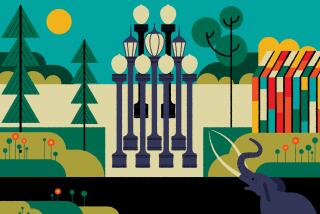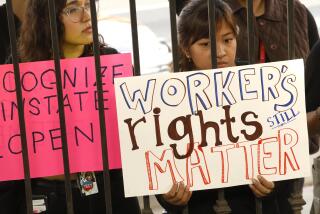American Indian museum hits stride
- Share via
WASHINGTON — In its first full month of operation, the National Museum of the American Indian had 275,400 visitors, a healthy start that puts the newcomer squarely in the middle range of the Mall’s museums. This is no small achievement given that two of its competitors -- the National Air and Space Museum and the National Museum of Natural History -- are among the most popular in the world.
If that pace continues, the museum is likely to attract about 4.2 million people in its first year. That is in line with the low end of its curators’ original estimates. At the time of its opening in September, they projected that the museum would attract 4 million to 6 million people and instituted a system of timed passes to spread out the crowds.
Calculating probable annual attendance from a new museum’s October experience involves many variables -- some as unpredictable as the weather. However, Stephen Fuller, a George Mason University economist who has studied the region’s economy and visitor patterns for years, says there are a few reliable guides. “October accounts for 6.5% of annual visitation for the large museums. So the October number at the Indian Museum is indicative. The October data suggests a total annual visitation of 4.2 million based on normal seasonal patterns,” says Fuller.
At the Indian Museum, with an average of 8,883 people a day coming through the doors last month, officials feel they are on the right track. “This is exactly what we expected,” said Carolyn Rapkevian, the deputy assistant director for public programs.
The Indian Museum’s attendance figures would make almost any of the country’s approximately 15,500 museums happy. Topping 1 million in any year is considered a milestone. A survey last year by the American Assn. of Museums found that the median annual attendance for U.S. art museums is 61,312 and for history museums, 15,000. The Indian Museum, with its galleries for art and its themed perspectives on history, straddles the categories.
Worldwide, the unquestioned turnout leader is the Smithsonian’s Air and Space Museum, which received 9.4 million visits in 2003. In the same year, the Louvre had 5.7 million visitors; the British Museum, 5.4 million; the Smithsonian’s Museum of Natural History, 5.2 million; the Metropolitan Museum of Art in New York, 5 million; the National Gallery of Art, 4.2 million; the American Museum of Natural History in New York, 3 million; and the Smithsonian’s Museum of American History, 2.6 million.
Hovering around the 1-million mark are nationally known art museums such as the Art Institute of Chicago, 1.7 million; the Museum of Fine Arts in Boston, 1.1 million; and the J. Paul Getty Museum in Los Angeles, 1 million.
Other destinations in that range include the Museum of Science in Boston, 1.6 million; the Field Museum, 1.3 million; and Colonial Williamsburg, which attracted 730,000 visitors. Many of these places, such as the Louvre, the American Museum of Natural History in New York and Colonial Williamsburg, charge admission. All of the Smithsonian’s museums are free.
New museums usually struggle to find a footing, says A. Wilson Greene, executive director of Pamplin Historical Park in Petersburg, Va., and a board member of the Institute for Museum and Library Services, a federal agency.
“In general, museums are like movies. If they are well publicized and meet with good feedback from the first people to see them, attendance tends to peak early in the release,” he says.
But newness also helps. The for-profit International Spy Museum originally expected 350,000 to 500,000 visitors annually. It drew 100,000 visitors its first month and broke 1 million in its first year. The U.S. Holocaust Memorial Museum originally expected several hundred thousand visitors annually, yet it too continues to attract 1 million a year. In 2000, when the natural history museum in New York opened its new planetarium and addition, it attracted 5 million people; attendance has since leveled out at 3 million. The Smithsonian’s own restoration of its mammal hall in the natural history museum and the opening of its military history hall in the American history museum attracted larger crowds than usual.
Fuller has examined attendance for the International Spy Museum, the future Center for American Diplomacy and the area’s hospitality industry. “From April to August, museums get 50% of their visitors,” he says. October is usually a good month but not the best, Fuller says, pointing out that business travelers are the most frequent visitors to town during that month.
But museum-goers are finicky. Some people go to museums when it rains; others stay home. If the Thanksgiving and Christmas holidays are storm-free and bring out family groups, the numbers rise. If Washington remains free from any terrorist attack, school groups will continue to flock. The crowds the presidential inauguration will attract are yet another factor.
“It is a rare year when nothing out of the ordinary happens,” Greene says.
More to Read
The biggest entertainment stories
Get our big stories about Hollywood, film, television, music, arts, culture and more right in your inbox as soon as they publish.
You may occasionally receive promotional content from the Los Angeles Times.










